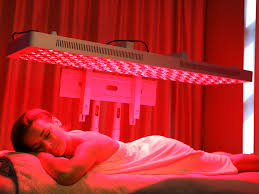Sunburned trying to “glow up”? Short answer: yes, Red Light Therapy can help soothe and heal sunburn faster. Whether you're using Red Light Therapy at Home, stylish Red Light Therapy Panels, or full‑body Red Light Therapy Beds, keep reading to see how light can rescue your crispy skin.

Understanding Sunburn and How Red Light Therapy Works
What is Sunburn?
The Science of UV Damage to Skin Cells
Ultraviolet (UV) rays harm the skin by disrupting cell DNA and weakening its protective layers. This sets off inflammation and a chain of repair responses. Over time, it may also accelerate skin ageing and increase sensitivity to future sun exposure.
Symptoms and Stages of Sunburn (Redness, Pain, Swelling, Peeling)
Sunburn typically develops in stages:
-
Redness and warmth appear first as blood vessels dilate
-
Pain and tenderness soon follow
-
In moderate cases, swelling or blisters may develop
-
Peeling usually occurs days later as dead cells shed during recovery
Introduction to Red Light Therapy (RLT)
How RLT Differs from Harmful UV Light (Non‑thermal, Non‑UV)
Red light therapy uses non‑UV, non‑thermal light. It does not cause burns or damage like UV rays do. Instead, it penetrates the skin gently, encouraging healing at the cellular level.
The Mechanism of Photobiomodulation (Cellular Energy/ATP, Mitochondria)
The light stimulates mitochondria—the energy centres of cells. This process, called photobiomodulation, increases ATP production. In turn, it accelerates healing, reduces inflammation, and supports regeneration.
The Healing Power of Red Light for Sunburnt Skin
Key Benefits of RLT for Sunburn Relief
Reducing Inflammation and Redness (Erythema)
Red light therapy helps soothe inflamed tissues by calming overactive blood vessels. This reduces visible redness and decreases heat in the skin. The skin often looks and feels less irritated within a few sessions.
Alleviating Pain and Discomfort
By increasing circulation and triggering endorphin release, RLT can ease pain and burning sensations. It offers a natural form of relief, especially useful for sensitive or swollen areas.
Accelerating Cellular Repair and Regeneration (DNA repair, wound healing)
Red light speeds up the repair of damaged skin cells and DNA. Healing becomes more efficient, reducing the time needed for recovery. This also helps avoid long‑term complications like discolouration or roughness.
Enhancing Circulation and Nutrient Delivery
Improved blood flow brings oxygen and nutrients to affected skin. This supports cellular regeneration and flushes out damaged cells. The result: faster, cleaner healing.
Supporting Skin Barrier Recovery and Preventing Peeling/Blistering
RLT encourages the growth of healthy skin, which helps maintain the skin barrier. This reduces the chances of peeling or secondary infections. With consistent use, the skin heals more evenly.
Scientific Evidence and Research
Clinical Studies Supporting RLT for Burns and UV Damage
Early studies on RLT for minor burns and UV‑damaged skin show positive outcomes. Participants often reported less pain and faster recovery than with traditional treatment alone. It’s not a miracle fix, but it can meaningfully support healing.
How RLT Promotes Collagen and Elastin Production (for long‑term skin health)
Red light stimulates the skin to produce collagen and elastin—proteins essential for skin strength and elasticity. This supports smoother, more youthful skin after damage has healed.
Anti‑Oxidative Stress Effects
RLT can reduce oxidative stress by limiting free radical activity. This helps protect cells from deeper UV-related harm during recovery.
How to Use Red Light Therapy for Sunburn Effectively

Practical Application for Sunburn Healing
When to Start RLT After Sun Exposure (Wait for initial heat to subside)
Wait until the initial heat or burning sensation subsides. Red light should not be applied to hot or actively inflamed skin. A few hours post‑exposure is usually a good window.
Recommended Session Duration and Frequency (e.g., 10–20 minutes, daily/every other day)
Use the device for 10–20 minutes per session, once or twice daily. Continue until the redness and discomfort have faded. Some may see results within two or three sessions.
Device Positioning and Coverage
Hold the red light 6–12 inches away from the affected skin. Ensure even exposure across the full sunburned area. Avoid contact with the skin surface to prevent unnecessary irritation.
Choosing the Right Device (Wavelengths, FDA‑cleared, at‑home vs. professional)
Choose a unit offering red light (around 660 nm) and near-infrared light (around 850 nm). Ensure it is CE or FDA-cleared for safety. Red Light Therapy Panels for home use are effective, but professional Red Light Therapy Beds may offer broader coverage.
Important Considerations and Safety Precautions
When to Avoid RLT (e.g., severely blistered skin, certain medications)
Do not use red light therapy on:
-
Broken or blistered skin
-
Skin recently treated with light‑sensitive medications
-
Areas affected by certain skin conditions (unless cleared by a doctor)
Consulting a Healthcare Professional
Severe sunburns, those with widespread blistering, or those affecting sensitive areas (like the face or eyes) may require medical care. Always consult your GP if in doubt, or if symptoms worsen.
Complementary Sunburn Care (Hydration, moisturisers, pain relievers)
RLT works best when paired with:
-
Cooling compresses
-
Hydrating moisturisers (such as aloe vera)
-
Adequate water intake
-
Avoidance of further sun exposure
-
Over-the-counter pain relief, if needed
Conclusion: Can Red Light Therapy Be Your Sunburn Ally?
Red light therapy won't erase a sunburn overnight, but it can support quicker, more comfortable recovery. From Red Light Therapy at Home devices to professional‑grade beds, the right light can calm redness, reduce pain, and help skin repair itself naturally.
Just remember—next time, don’t skip the SPF.






